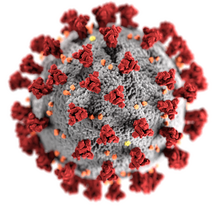Student Projects/Coronavirus

Coronavirus or COVID-19 is a worldwide parasite and infectious disease or virus caused by a newly discovered coronavirus back in December 2019 when the Chinese authorities informed the world that the virus had spread but scientists discovered that bats had spread it.
Most people infected with the COVID-19 virus will experience mild to moderate respiratory illness and recover without requiring special treatment. Older people, And those with underlying medical problems like cardiovascular disease, diabetes, chronic respiratory disease, and cancer are more likely to develop serious illness.
What is the actual virus made up of?
[edit | edit source]The actual virus is made up of other viruses. They include SARS CoV, which causes severe acute respiratory syndrome, MERS CoV, which causes Middle East respiratory syndrome, and SARS CoV 2 causes COVID-19, also known as Severe Acute Respiratory Syndrome Coronavirus 2.[1]
How does the virus enter the human body?
[edit | edit source]Example:
The virus may in all likelihood enter the body if an infected person coughs or sneezes, and droplets or particles from inside your mouth or nose exit. This is due to the fact that they are in the mucus or germs that exit your body. The virus would spread to an uninfected person if they are close to the infected person, and the particles enter the uninflected person’s body by entering the nose or mouth, then the trachea and likely the lungs, where the virus can have the most dramatic effects.[2]
What happens once the virus is inside the human body?
[edit | edit source]Inside the body, it embeds itself in one of the uninfected person’s cells, and the infected cell receives copies of the original virus before self-destructing. This is when the infected cell commits suicide by melting away, releasing new Coronavirus particles into the body.[3]The new particles infect the other uninfected cells, which leads to more genetic mutation in the cells until they self destruct, or commit suicide. This can lead to more particles entering the body, and they will eventually spread to other organs. If they affect the lungs, the alveoli, tiny air sacs via which breathing occurs, become damaged and may render the now infected person unable to breathe. This is called pneumonia, and due to this symptom, infected people need ventilators to survive, or the symptoms may inevitably lead to death if the virus affects your lungs or even the entire immune system even more.
How does the immune system defend itself?
[edit | edit source]If vaccinated, an infected person’s immune system will develop antibodies due to memory cells ordering them to produce antiviral weapons. In this case, the virus will be intercepted by the antibodies, which attach to the proteins on the outer layer of the pathogen, meaning the virus will be prevented from attaching to cells. The antibodies will eventually kill the pathogen once they have attached to it.[4]In some cases, cells in your immune system called macrophages begin to produce cytokines, inner proteins of human or animal cells. If the cytokines rapidly multiply, a cytokine storm will start and the body will be overwhelmed due to the uncontrolled level of cytokines. The body will begin to attack itself if this becomes the case.
References
[edit | edit source]- ↑ Information given by scientists from TED Ed, and Kurzgesagt — In a Nutshell.
- ↑ Simple English Wikipedia: Coronavirus
- ↑ Cited by a scientist from Kurzgesagt.
- ↑ Cited by a scientist from educational YouTube channel What If.
